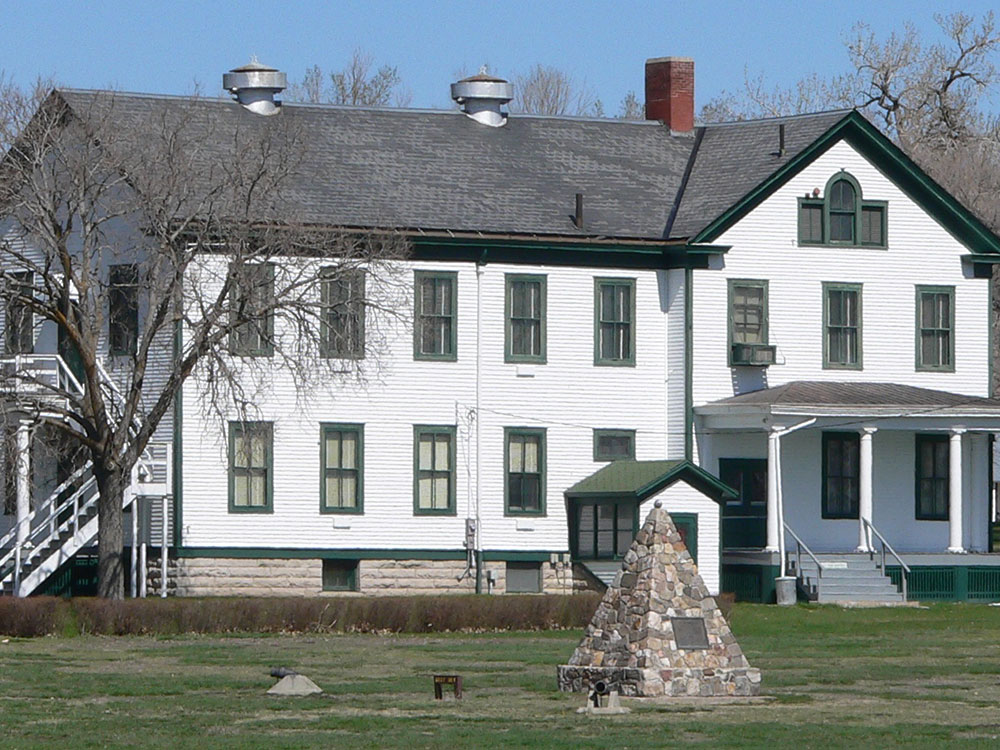General Information
Resident Park Permit Daily Pass: $6.00
Non-Resident Park Permit Daily Pass: $12.00
How to Get There
From Scottsbluff (77 miles): Follow W 20th St and W Railway St to Ave I. Follow NE-71 N to Soldier Creek Rd in Dawes County. Continue on Soldier Creek Rd to destination.
Overview
Fort Robinson is a former U.S. Army fort and now a major feature of Fort Robinson State Park, a 22,000-acre (8,900 ha) public recreation and historic preservation area located 2 miles (3.2 km) west of Crawford on U.S. Route 20 in the Pine Ridge region of northwest Nebraska.

The fort was declared a National Historic Landmark in 1960 and is part of the Fort Robinson and Red Cloud Agency historic district. This includes Fort Robinson and the site of the second Red Cloud Agency (about 1.5 mi (2.4 km) to the east). The district also includes the Camp Camby site and the 1886 Percy Homestead. The fort is managed by the Nebraska Game and Parks Commission, with some individual buildings operated by the History Nebraska and the University of Nebraska.
In August 1873, the Red Cloud Agency was moved from the North Platte River to the White River, near what is now Crawford, Nebraska, in the northwest corner of the state. The following March, the U. S. Government authorized the establishment of a military camp at the agency site. Some 13,000 Lakota had been subject to resettlement.
The camp was named Camp Robinson in honor of Lt. Levi H. Robinson, who had been killed by Indians while on Indian land in February. In May, the military camp was moved 1.5 miles (2.4 km) west of the agency to its present location; the camp was renamed Fort Robinson in January 1878.
Fort Robinson was a base of US military forces and played a major role in the Sioux Wars from 1876 to 1890. The Battle of Warbonnet Creek took place nearby in July 1876. The war chief Crazy Horse surrendered here with his defenders on May 6, 1877. On September 5 that year, he was killed while resisting imprisonment. A historic plaque marks the site of his death.
The U.S. Army decided to abandon Fort Robinson in 1947; in the following year, it transferred the property to the U.S. Department of Agriculture (USDA), for its Beef Cattle Research Station. After some buildings were demolished in the mid-1950s, efforts were made to preserve the fort as a historic site. In 1955, History Nebraska, formally the Nebraska State Historical Society, began to acquire property on the fort; in 1956, they opened a museum on the site. The USDA closed its operation in 1971, and transferred the property to the state of Nebraska.
The Fort Robinson State Park was established in 1956 following the purchase of a parcel of land by the Nebraska Game, Forestation and Parks Commission in 1955. The park was expanded after much of the site was deeded over from the Federal government in 1964. It reached its full size with Nebraska's purchase of the adjoining James Arthur Ranch in 1972.
The fort's historic buildings and sites include the 1904 blacksmith shop, the 1908 veterinary hospital, the 1887 officers' quarters, the 1875 guardhouse and adjutant's office, and the post cemetery. There is also a library with materials about Fort Robinson and military and western history available for research. A quartermaster's stores building is now used as a playhouse.
The Fort Robinson Museum is located in the 1905 post headquarters building. Exhibits focus on the fort's history, including its role guarding the Red Cloud Agency from 1874 to 1877, up through the housing of World War II German POWs from 1943 to 1946. The Trailside Museum of Natural History, operated by the University of Nebraska State Museum, is located in the historic Army Theatre building.
This article uses material from the Wikipedia article "Fort Robinson", which is released under the Creative Commons Attribution-Share-Alike License 3.0